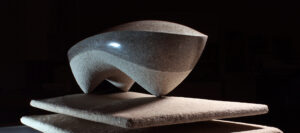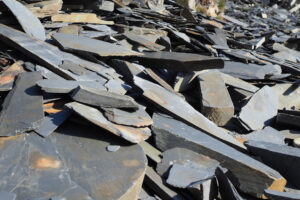
Home » Carve » Hard Stone » The Stone Corner – Anhydrite -Sept/Oct 1997
Anhydrite has not been a widely popular stone, but its availability on the west coast of North American and the beauty of its finish is likely to result in more sculpture exbibits in the future. It has the pearly luster of alabaster and yet carves and finishes more like the harder stones.
Geology
Anhydrite is both a mineral and a sedimentary rock. Its name comes from the Greek for “without water”; essentially it is the anhydrous form of calcium sulfite (CaSo4). Anhydrite is the sister or brother of alabaster (gypsum), which is the hydrated form of calcium sulfate. Two molecules of water are attached to each molecule of calcium sulfate in gypsum.
Anhydrite commonly is found in white, gray, brown and light red or pink. It is heavier than alabaster, weighing in at about 187 pounds per cubic foot with a specific gravity of 3.0. One of the key differences between alabaster and anhydrite is the hardness: alabaster is 2 and anhydrite ranges from 3 to 3.5. It is insoluble in hydrochloric acid and sulfuric acid; however, it is easily attacked by water. in the earth, anhydrite converts to gypsum when it absorbs water; and in your yard, it will break down with facility if exposed to the elements.
Anhydrite is one of a group of rock-forming minerals called evaporites, so called because they form by the precipitation of the minerals from evaporating brines or salt water. The other evaporties are gypsum and halite (salt). They form in shallow salt water seas that are alternately submerged and de-watered. Beds of the rocks can be found in the thicknesses of a few hundred feet. Which mineral is precipitated at any time depends n the temperature, pressure and salinity of the water. At higher temperatures, anhydrite is the first one to precipitate, followed by gypsum, however, at lower temperatures, te opposite is the case. Halite is normally the last to form. In the laboratory, and presumably in nature, gypsum and anhydrite can be made to convert to one another by the changing of pressure and temperature. It is also known that anhydrite can be changed to gypsum by the addition of water, such as during the weathering process; and conversely, the reverse can be achieved by the baking or drying of gypsum.
In North America, anhydrite is found in the salt domes of Louisiana and Texas and in stratified deposits in Nova Scotia, New York, New Mexico and British Columbia. It is also in large layered salt deposits of Poland, Germany, Austria, France and lndia. It is not considered an important industrial mineral. In large deposits of gypsum, it is considered to be a contaminant. It is used as a source oj sulfuric acid, as a retardant for concrete, for a filler in paper and as a soil conditioner.
Quarrying
Although anhydrite is relatively hard stone, it is somewhat easy to mine because it si cut by numerous joints. Therefore, for the quantities needed for sculptural purposes, it is not necessary to blast to obtain. If blasted, this stone would probably shatter and much of the stone would be unstable. It is removed from the ground or rock face by hand tools or with a backhoe. The best method for determining the integrity of the stone is to tap the stone with a hammer and listen carefully for changes n the ring.
Working Anhydrite
Anhydrite is brittle and hand tool working is not recommended. Although a harness of 3 to 3.5 is not extreme, sculptors who have worked the stone definitely prefer the use of power tools for working this stone. Chisels tend to create small chips corners are commonly lost because an unexpected piece breaks off. The good part is that anhydrite unlikely to bruise in the manner that alabaster does.
It can be worked with a hand-held grinder as well as a stationary wheel, and the stone cuts very evenly and easily with such tools. Anhydrite takes well to a grinder, and carbide disks will show little wear after working the stone.
Anhydrite can be taken to a 70 to 600 grit finish. depending on the pattern of the stone, and buffed with tin oxide using a wet rag or a mechanical buffer. Of all of the colors, white produces the most lustrous finish although brown may have the most interesting patterns.
Flaws
Cracks and joints are not common flaws in anhydrite. In general, it is a solid stone. The white variety tends to be the most consistent in color and hardness. The brown stone can be more variable in hardness, containing scattered softer spots. Sometimes, small white spots may be present in the stone.
Although not exactly a flaw of the stone, a major weakness of all anhydrite is its susceptibility to water. It must be kept indoors before and after carving. If left outdoors, it will absorb water and start to deteriorate.
Safety
No particular safety hazards were reported for anhydrite; however, we all need to remember to protect out lung, eyes and ears at all times. Be a sage and safe sculptor.
Appreciation
Thanks to Randy Zeiber of Vancouver, British Columbia for his quarrying and carving expertise and Carol Way and Vic Picou of Seattle, Washington for sharing their carving experiences with me.
Editor’s Note: I could not locate a picture of a sculpture done in anhydrite for this issue. I hope to have one for the next issue. This concludes the series on stone. I know I speak for the readers of Sculpture Northwest is expressing appreciation to Bill Laprade for this interesting and informative series.






We need some kind of descriptive text here.